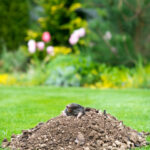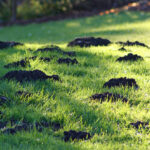How Can We Help?
How do I determine if I have a mole problem in my garden?
Figuring out if you have a mole problem in your garden means spotting a few key signs. One of the most obvious is the appearance of molehills – those small, conical mounds of soil that moles push up as they dig their tunnels. These  molehills are usually found near tunnel entrances or feeding spots. Another sign to look out for is surface tunnels or ridges, known as mole runs, which moles create while searching for food underground. These tunnels can mess with plants and grassroots, impacting the garden's look and plant health. Since moles mainly eat earthworms and grubs, you might notice plants wilting or dying because their roots are disturbed or they're lacking nutrients. Also, if your pets start digging or act strangely in a specific part of the garden, it could be an indication of mole activity underground. Keeping an eye on these signs and noticing patterns of damage can help you confirm if moles are around and prompt you to take steps to deal with the problem.
molehills are usually found near tunnel entrances or feeding spots. Another sign to look out for is surface tunnels or ridges, known as mole runs, which moles create while searching for food underground. These tunnels can mess with plants and grassroots, impacting the garden's look and plant health. Since moles mainly eat earthworms and grubs, you might notice plants wilting or dying because their roots are disturbed or they're lacking nutrients. Also, if your pets start digging or act strangely in a specific part of the garden, it could be an indication of mole activity underground. Keeping an eye on these signs and noticing patterns of damage can help you confirm if moles are around and prompt you to take steps to deal with the problem.
Are there certain times of year when mole activity is more noticeable?
Mole activity can change throughout the year, with different seasons and environmental conditions affecting their behavior and visibility in gardens. You'll generally notice more mole activity during the spring and autumn. In spring, moles get busier as they come out of the deeper tunnels where they spent the winter. They're drawn out by the warmer temps, increased soil moisture, and the abundance of earthworms and other insects that become more active. Spring is also breeding season for moles, which boosts their activity as they establish territories and look for mates.
Autumn is another busy time for moles. As it gets cooler and the soil stays moist from autumn rains, moles get active again, preparing for winter. They're often focused on foraging and storing food to get through the colder months when insects are less active. Autumn is also when moles might expand their tunnels or create new ones to access food more efficiently.
On the flip side, mole activity usually drops during the hot and dry summer months and the cold winter months. In summer, moles might retreat to deeper parts of their tunnels or stay less active during the day to avoid dehydration and heat stress. In winter, they dig deeper tunnels below the frost line where the soil is more stable in temperature,
By understanding these seasonal patterns, gardeners can better anticipate and manage mole activity. Regularly checking your garden for mole signs, like molehills, surface tunnels, and plant damage, can offer valuable insights into their presence and behaviors year-round. Using integrated pest management strategies that consider these seasonal variations can help minimise mole damage and keep your garden healthy and looking great.
Do moles cause damage to plant roots and garden beds?
Yes, moles can mess up plant roots and garden beds with their tunneling. Moles are insectivores that mainly eat earthworms, grubs, and other insects in the soil. As they dig around for food, they can disturb the roots of plants, especially those with shallow roots. This can cause plants to become uprooted, affecting their stability and ability to absorb nutrients and water. In garden beds, moles create a maze of tunnels just below the surface, making the soil loose and uneven. This can make it tough to establish or maintain plantings since roots need stable soil to anchor in. Additionally, molehills can smother young plants or seedlings if not promptly cleared. The digging can also mess with irrigation systems and create pathways for water to drain away from plants, leading to uneven moisture levels. Moreover, mole tunnels can serve as routes for other pests like voles or mice, which can further damage plant roots or bulbs. To reduce mole damage, gardeners can use various strategies like installing underground barriers or mesh to keep moles out. Natural repellents, such as castor oil-based products, might also help keep moles from digging in certain areas. Keeping an eye on molehills and removing them quickly can minimize soil disruption and protect plants.
Should I be concerned about mole tunnels near my home's foundation?
Yes, mole tunnels near your home's foundation can be concerning due to potential structural and environmental impacts. While moles mainly dig tunnels looking for food and don't intentionally damage structures, their extensive digging can indirectly affect your home's foundation. Mole tunnels can weaken the soil around the foundation, leading to erosion and destabilization. Over time, this can make the soil shift or settle unevenly, which might result in cracks or other foundation issues.
Additionally, mole tunnels near the foundation can create pathways for water to seep in. During heavy rains or 
Moreover, mole tunnels can attract other pests. The loose soil and pathways created by moles can make it easier for rodents, like mice and rats, to infiltrate your home. These secondary pests can bring additional problems, including property damage and health concerns due to the potential spread of diseases.
Preventing and managing mole activity near your foundation is crucial to mitigating these risks. Effective strategies include installing physical barriers, like underground fencing or mesh, to deter moles from tunneling close to the foundation. Here at Youngs Pest Control, we provide regular inspections of your home's perimeter for signs of mole activity, and addressing any issues promptly can help prevent further tunneling.
